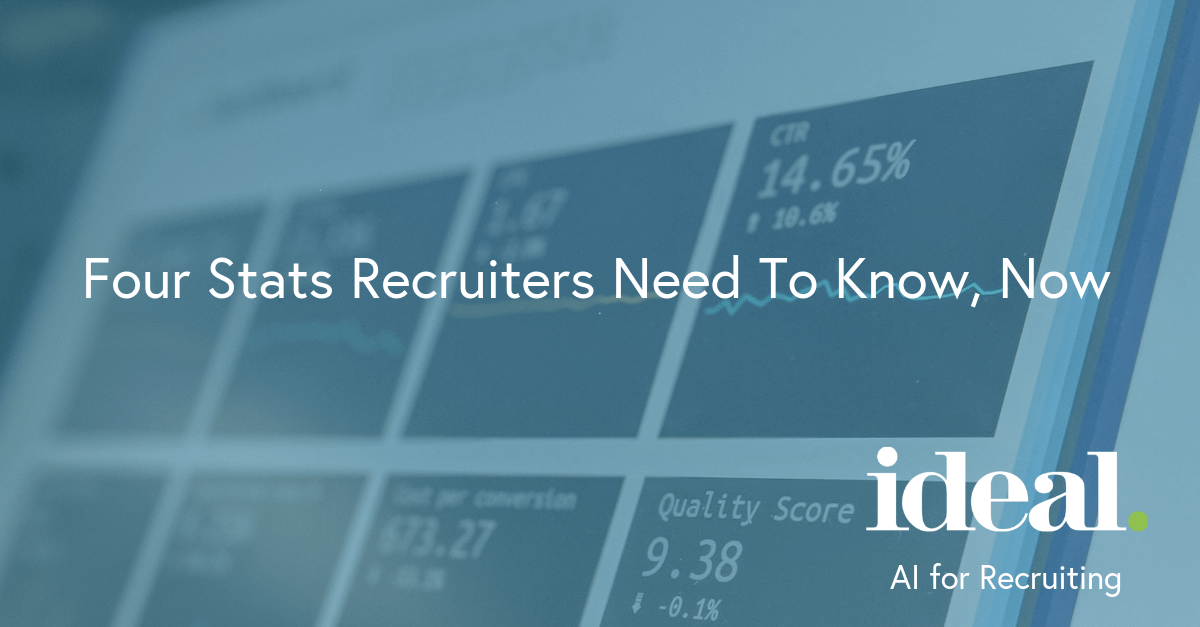Have you been wondering what stats your recruiters need to know?

Thanks to the record-low unemployment rate, hiring and recruiting are more difficult than ever. Job-seekers have their pick of positions, so keeping your process as streamlined and efficient as possible is key to convincing candidates to choose your company.
The hiring process is often treated as an indicator of how the job itself will be. According to a recent CareerBuilder and SilkRoad survey, 68% of employees believe their experiences as job candidates reflect how the company treats its people.
That same survey found nearly half of employers reported it’s taking longer to fill jobs than ever before.
To improve your hiring process, there are certain stats your hiring managers and recruiters should be tracking, such as how long the entire hiring cycle takes and what recruiting methods have the best retention rates.
Knowing these statistics can make a significant impact on how you move forward with recruiting and can ultimately lead to more successful hires and better strategies for the future.
Time to fill
Do you know offhand how long it took to bring on your newest hire, from posting the job opening to the person’s first day? If not, you’ll want to figure out how long it took, since it’s helpful with planning for the future.
The less time between advertising for the position and the onboarding process, the more efficient your hiring and recruiting are.
Sixty percent of employers in the CareerBuilder survey said they’re seeing longer times to fill positions in the past year, which they directly blame on the tough hiring environment.
In addition, having a long wait time between when a job is posted and when someone is hired can lead to qualified candidates dropping out of the running. It’s a job-seeker’s market, so top talent won’t waste time waiting around for weeks – they’ll move on and you’ll be left in the dust. In fact, 55% of employees said they’d move on if they haven’t heard from an employer within two weeks of submitting an application.
A faster time-to-hire can also have a positive effect on the rest of your team, since they won’t be filling in for that empty spot very long and the instability that comes with a missing team member will be short-lived.
Being aware of how long it takes your hiring team to complete this process means you can see where the lags are and fix them. Whether it’s a specific hiring manager who always takes a long time to schedule interviews or a lack of communication between your team, seeing where you might be falling short is helpful.
To monitor this process, you may want to consider using an HR management system (HRMS) solution, which can measure the average time it takes your team to fill an open position and provide additional data on where you’re succeeding and what needs to improve.
This also allows you to provide candidates with a clear timeline and regular updates on the process, something that 82% of employees expect when applying for a new job.
Hiring source
Another statistic you’ll want to keep an eye on is where your best candidates are coming from. Since recruiters aren’t as limited now, the era of job boards dominating the sourcing scene is on its way out.
With social media, sourcing agencies and more updated company websites, it’s easier than ever for talent to find your postings. But you don’t want to spend time recruiting through certain channels if they’re not providing the best candidates.
Monitoring where your best recruits come from helps you allocate resources more effectively, since you won’t waste time focusing on areas where few people will see your open position.
Hire quality
Using high-quality sources should mean you’re making quality hires, but you still want to ensure your new employee is primed for success and doing well.
Keep an eye on the hire’s performance over his or her first year. When the hire is performing well, it usually means the choice was right, but a mediocre or bad performance can signal issues within your recruiting process.
An HRMS solution can also offer a quick and easy way to access all employee information, including performance reviews and other quality metrics.
Knowing the quality of your hire also helps your team understand the quality of your sourcing. If all your high performers found the posting on LinkedIn, consider investing more time and resources into your social media presence.
Candidate job satisfaction
One of the most important areas to watch is whether your hires are happy at their jobs. It’s a good way to see if expectations for the position match the reality and can help you fine-tune the way you write job descriptions.
Another statistic related to this is whether the candidate lasts a full year at the organization. If they don’t, it likely means they were either a bad fit with the team or the job description wasn’t accurate.
Knowing this info can improve your hiring process, since you’ll know how well you’re selling the job.
Bottom line
Ultimately, being aware of these recruiting statistics benefits your hiring in the long run because it points out potential pitfalls while also focusing on what your team does well.
And knowing where you stand is good for your recruitment, new employees and your company at large.
Kelsy Ketchum is an editor for Better Buys, helping companies find and select the right software solution. She also writes about medical coding, human resources and safety compliance.
